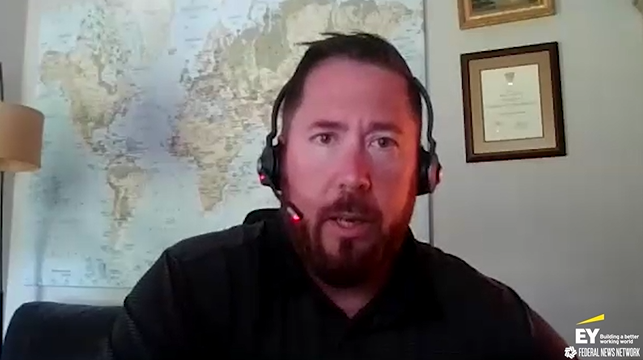When it comes to AI at Energy, it takes a village

Federal chief data officers are playing a larger role in how their organizations are adopting and using basic or advanced artificial intelligence (AI).
A recent survey of federal chief data officers by the Data Foundation found over half of the CDOs who responded say their role around AI has significantly changed over the past year, as compared to 2022 when 45% said they had no AI responsibility.
Taking this a step further, with nearly every agency naming a chief AI officer over the past year, the coordination and collaboration between the CDO and these new leaders has emerged as a key factor in the success of any agency AI program.
“We are taking a collaborative and integrated approach to aligning data into artificial intelligence and building synergies between the role of data and data governance, and really being able to meet the spirit of the requirements of the AI executive order, with the ability to interrogate our data ethically and without bias as they are being imported into artificial intelligence models,” said Rob King, the chief data officer at the Energy Department, on the discussion Government Modernization Unleashed: AI Essentials. “We’re really now trying to ensure that we can back in the appropriate governance management, make sure we have oversight of our AI inventories and start to align the right controls in place from a metadata management and from a training data standpoint, so that we can meet both the letter and the spirit of the AI executive order. We don’t just want to be compliance driven, but ensure that we are doing the right thing to leverage those AI models to their full extent, and make sure that we can accelerate the adoption of them more broadly.”
For that adoption that King talks about to happen more broadly and more quickly, data must be prepared, managed and curated to ensure the AI, or really any technology tool, works well.
CDOs in a unique position
He said AI is just the latest accelerator that has come along that reemphasizes the importance of understanding and protecting an organization’s data.
“How do we use AI to help us look for themes, patterns of usages in our data to advance the classification and tagging of our data from a stewardship standpoint, so that we can understand that whole full cycle? We’re calling things like data-centric AI to ensure that we’re looking at ways to use non-invasive data governance approaches to help meet the mission needs of AI. It’s a great feedback loop,” King said. “We’re using AI to drive the maturity of our processes so that we can advance the mission adoption of AI as well. The CDOs are in a unique position because we live by the tenets of ‘it takes a village.’ It takes us working with policy and process leaders, and now the chief AI officers (CAIOs) and mission stakeholders, bringing us all together to really drive the outcomes of strong data management practices, now aligned to positioning for AI adoption.”
King, who has been the CDO at Energy for almost a year, said policies like the Federal Data Strategy or the Evidence-Based Policymaking Act have created a solid foundation, but the hard work that still must happen will be by CDOs and CAIOs as they put those concepts into action.
One way King started down this data management journey is by developing an enterprise data strategy and “recharged” DoE’s data governance board by ensuring all the right stakeholders with the right subject matter expertise and relevancy are participating.
“We’re on the precipice of completing that strategy. It’s been published in a draft format to our entire data governance board members for final review and edit. We hope to bring that to the finish line in the next few weeks,” he said. “From there, we’re already moving right into a five-year implementation plan, breaking it down by annual increments to promote that strategy, recognizing that our science complex, our weapons complex and our environmental complexes have very different needs.”
Testing AI has begun
The new data strategy will lay out what King called the “North Star” goals for DoE around data management and governance.
He said the strategy details five strategy goals, each with several objectives and related actions.
“We wanted to make sure that everyone could see themselves in the strategy. The implementation plan is going to be much more nuanced. We’re now taking key stakeholders from our data governance group and building a team with appropriate subject matter experts and mission representatives to build out that implementation plan and to account for those major data types,” he said. “The other thing we’re starting to look at in our strategy is [asking] what is the right ontology for data sharing? We should have a conceptual mission architecture that can show where we can accelerate our missions, be it on the weapons side or on the science and research side. Where can we build ontologies that say we can accelerate the mission? Because we’re seeing like functions and like activities that, because of our federated nature at the Department of Energy, we can break down those silos, show where there’s that shared equity. That could be some natural data sharing agreements that we could facilitate and accelerate mission functions or science.”
Even as Energy finalizes its data strategy, its bureaus and labs aren’t waiting to begin testing and piloting AI tools. Energy has several potential and real use cases for AI already under consideration or in the works. King said applying AI to mission critical priorities like moving to a zero trust architecture and in the cyber domain is one example. Another is applying AI to hazards analysis through DoE’s national labs.
King said the CDO and CAIO are identifying leaders and then sharing how they are applying AI to other mission areas.
“I’m trying to partner with them to understand how I can scale and emulate their goodness, both from pure data management standpoint as well as artificial intelligence,” he said. “We have one that the National Nuclear Security Administration is leading, called Project Alexandra, around non-nuclear proliferation. They’re doing a lot of great things. So how do we take that and scale it for its goodness? We are seeing some strategic use cases that are of high importance. The AI executive order says our foundational models need to be published to other government agencies, academia and industry for interrogation. So how do we then start to, with the chief AI officer, say what is our risk assessment? And what is our data quality assessment for being able to publish our foundational models to those stakeholders for that interrogation? How do we start to align our data governance strategy and use cases to some of our AI drivers?”
Copyright
© 2024 Federal News Network. All rights reserved. This website is not intended for users located within the European Economic Area.



